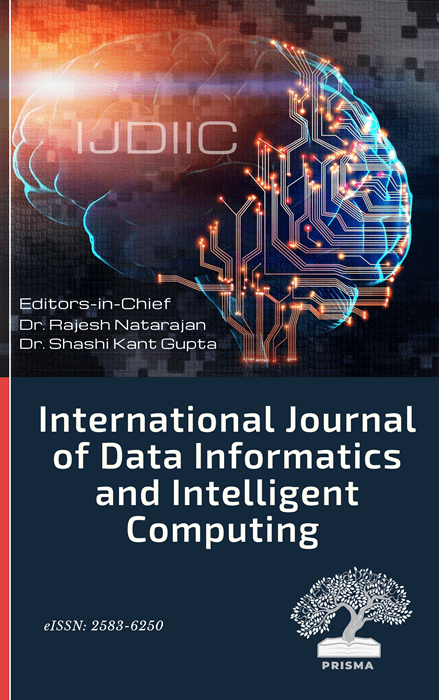Sentiment Analysis and Topic Classification with LSTM Networks and TextRazor
DOI:
https://doi.org/10.59461/ijdiic.v3i2.115Keywords:
Sentiment analysis, LSTM, TextRazor, TwitterAbstract
In the ever-evolving landscape of social media, where user-generated content shapes digital discourse, the need for nuanced sentiment analysis and topic extraction is paramount. This paper presents a comprehensive approach utilizing advanced Natural Language Processing (NLP) techniques to enhance user experience and foster a healthier digital environment. Leveraging Long Short-Term Memory (LSTM) networks for sentiment analysis and TextRazor for topic extraction, the system provides insights into emotional tones and key themes within social media discussions. Through intuitive visualizations, users gain awareness of sentiment trends and topic distributions, empowering informed engagement. The results demonstrate high accuracy in sentiment classification with 86% and effective topic identification, contributing to the mitigation of misinformation and negativity online. This research underscores the potential of advanced NLP methods in cultivating constructive digital spaces and sets the stage for further innovation in the field.
Downloads
References
O. Almonajed and S. Jukić, “Sentiment Analysis on Twitter Data using Big Data,” J. Eng. Nat. Sci., vol. 3, no. 1, 2021, doi: 10.14706/JONSAE2021311.
N. C. Dang, M. N. Moreno-García, and F. De la Prieta, “Sentiment Analysis Based on Deep Learning: A Comparative Study,” Electronics, vol. 9, no. 3, p. 483, Mar. 2020, doi: 10.3390/electronics9030483.
M. Furini and M. Montangero, “Sentiment analysis and Twitter: a game proposal,” Pers. Ubiquitous Comput., vol. 22, no. 4, pp. 771–785, Aug. 2018, doi: 10.1007/s00779-018-1142-5.
C. Weisser et al., “Pseudo-document simulation for comparing LDA, GSDMM and GPM topic models on short and sparse text using Twitter data,” Comput. Stat., vol. 38, no. 2, pp. 647–674, Jun. 2023, doi: 10.1007/s00180-022-01246-z.
Y. Chai, D. Kakkar, J. Palacios, and S. Zheng, “Twitter Sentiment Geographical Index Dataset,” Sci. Data, vol. 10, no. 1, p. 684, Oct. 2023, doi: 10.1038/s41597-023-02572-7.
Y. Qi and Z. Shabrina, “Sentiment analysis using Twitter data: a comparative application of lexicon- and machine-learning-based approach,” Soc. Netw. Anal. Min., vol. 13, no. 1, p. 31, Feb. 2023, doi: 10.1007/s13278-023-01030-x.
L. Zhang, S. Wang, and B. Liu, “Deep learning for sentiment analysis: A survey,” WIREs Data Min. Knowl. Discov., vol. 8, no. 4, Jul. 2018, doi: 10.1002/widm.1253.
U. Naseem, I. Razzak, M. Khushi, P. W. Eklund, and J. Kim, “COVIDSenti: A Large-Scale Benchmark Twitter Data Set for COVID-19 Sentiment Analysis,” IEEE Trans. Comput. Soc. Syst., vol. 8, no. 4, pp. 1003–1015, Aug. 2021, doi: 10.1109/TCSS.2021.3051189.
P. Mishra, S. A. Patil, U. Shehroj, P. Aniyeri, and T. A. Khan, “Twitter Sentiment Analysis using Naive Bayes Algorithm,” in 2022 3rd International Informatics and Software Engineering Conference (IISEC), IEEE, Dec. 2022, pp. 1–5. doi: 10.1109/IISEC56263.2022.9998252.
A. S. M. Alharbi and E. de Doncker, “Twitter sentiment analysis with a deep neural network: An enhanced approach using user behavioral information,” Cogn. Syst. Res., vol. 54, pp. 50–61, May 2019, doi: 10.1016/j.cogsys.2018.10.001.
A. Aljebreen, W. Meng, and E. Dragut, “Segmentation of Tweets with URLs and its Applications to Sentiment Analysis,” Proc. AAAI Conf. Artif. Intell., vol. 35, no. 14, pp. 12480–12488, May 2021, doi: 10.1609/aaai.v35i14.17480.
Y. Yu, X. Si, C. Hu, and J. Zhang, “A Review of Recurrent Neural Networks: LSTM Cells and Network Architectures,” Neural Comput., vol. 31, no. 7, pp. 1235–1270, Jul. 2019, doi: 10.1162/neco_a_01199.
A. Farzad, H. Mashayekhi, and H. Hassanpour, “A comparative performance analysis of different activation functions in LSTM networks for classification,” Neural Comput. Appl., vol. 31, no. 7, pp. 2507–2521, Jul. 2019, doi: 10.1007/s00521-017-3210-6.
Downloads
Published
How to Cite
Issue
Section
License
Copyright (c) 2024 Jency Jose, Simritha R

This work is licensed under a Creative Commons Attribution-ShareAlike 4.0 International License.








